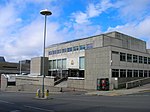Amex House

Amex House, popularly nicknamed The Wedding Cake, was the former European headquarters of American Express, the multinational financial services company. Its site is located in the Carlton Hill area of Brighton, part of the English city of Brighton and Hove. The nine-floor building, designed by British architecture firm Gollins, Melvin, Ward & Partners, was commissioned by the company in 1977 to consolidate their operations in Brighton, which had been spread over several sites. The white and blue structure, a landmark on the city skyline, received both praise and criticism for its distinctive style. Demolition work began in April 2016 after the completion of a new headquarters building on land owned by American Express adjacent to the site. In October 2017 demolition was completed and the site was sold to First Base and Patron Capital, a pan-European institutional investor focused on property backed investments who proposed "a vibrant new mixed-use development including new homes, workspace and importantly, new jobs to revive this area of Brighton".
Excerpt from the Wikipedia article Amex House (License: CC BY-SA 3.0, Authors, Images).Amex House
Mighell Street, Brighton Queen's Park
Geographical coordinates (GPS) Address Nearby Places Show on map
Geographical coordinates (GPS)
| Latitude | Longitude |
|---|---|
| N 50.823 ° | E -0.1328 ° |
Address
Mighell Street
Mighell Street
BN2 0BE Brighton, Queen's Park
England, United Kingdom
Open on Google Maps










